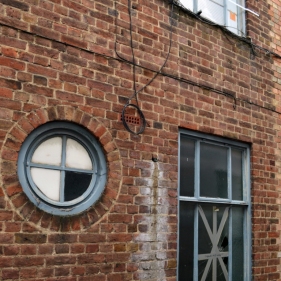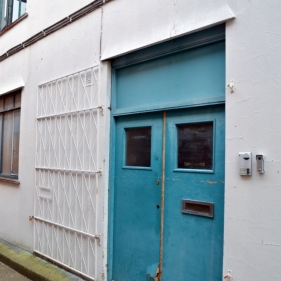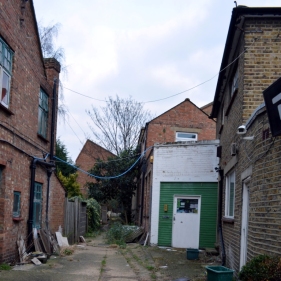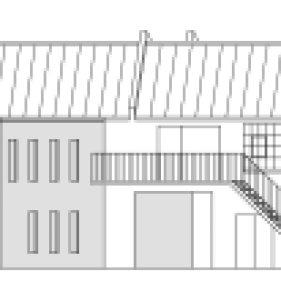
Two tales from World War Two
Trying to understand today what it must have been like to be a civilian during the Second World War in Kingston is quite impossible. The continuous threat from bombardment, the rationing, the worry for loved ones on the front, carrying your gas mask everyone, queues for the buses, houses destroyed down your street, patches of intelligence about the atrocities in the East – the sheer pressure of the situation, and the only consolation that it least it was shared by everybody, and we were just “another south-west suburb” (Surrey Comet, 1944). This blog is about two aspects of the war experience in Park Road, Kingston: bombardment and war time manufacturing.

“V Bomb Kills Five”
There were a number of HE (High Explosive) bomb strikes on or near Park Road early in the war recorded by the ARP Wardens of Kingston Council on a ‘Bomb Map’ available at Kingston History Centre. They were at 20:43 on 30/10/1940, 19:19 on 12/11/1940 and 20:33 on 29/11/1940. The Park Road – New Road junction was also the location for the only V-2 rocket to land in the former Borough of Kingston, the present monument at the site erected in 1995.
V-2s were retribution weapons, the first long-range guided ballistic missiles, sent over London by the German Luftwaffe as payback for the effective bombardment of German cities by the Allies. According to Wikipedia, modern reconstructions estimate that they create a crater of 20m wide, by 8m deep, ejecting around 3000 tons of material into the surroundings.
The bomb landed at 14:35 on Monday, 22nd January 1945. The article to the right is how the Surrey Comet wrote about it in their issue of 27th January 1945, page 7.
Later, A.W. Forsdike, Town Clerk and ARP Controller, wrote a report on the incident. There were 5 immediate fatalities, and 3 later in hospital as well as 120 injured. The injured were treated at the Aid Post and Kingston Hospital: “at one period it was thought that the hospital may become congested”. In total, 40 people were hospitalised. Kings Road, Tudor Road, New Road and Elm Road were also damaged with a total 2004 houses affected (33 demolished, 80 seriously damaged).
His report describes how “the most severe and widespread incident in the Borough” was managed by a mixture of civilian volunteers and service personnel. ARP Wardens, the National Fire Service and Police were in action by 14:42. British soldiers from the nearby barracks and American Forces from encampment in Richmond Park cleared the roads within 3 hours. A mobile First Aid post was set up by the Women’s Voluntary Service and Housewives. Dangerous work was carried out to rescue those under rubble by Wardens and the Heavy and Light Rescue Parties from the Borough’s Villier’s Road Depot, led by a man called Coulton: “All the living casualties were extricated within about an hour”.
Incident Control was set up in houses opposite Alexandra Hotel for three weeks, manned by ARP Wardens. An Enquiry Point was managed by the WVS for one week after the event and they also managed a large number of curved asbestos huts later erected to meet the housing shortage on the road. Forsdike wrote that: “Owing to the tremendous demand for labour in the London area, we are only permitted to repair houses up to a standard laid down by the Ministry and known as “reasonable comfort”. Plastering, painting and distempering (except patching) at the present stage, is entirely prohibited, except under exceptional circumstances.”
For me, the most evocative and poignant description in the newspaper article is the call by rescuers for silence. Silence. Silence, in order to listen for life, rescuers ‘holding their breath whilst…bent low and strained to hear a noise which would guide them to a rescue’ (Surrey Comet, 27/1/1945). It is unsettling to imagine the scene, as children were dragged alive from the rubble.
Park Works, 16 Park Road
One way in which we remember the past is through the designation of the built environment as having some sort of historical interest: this could be through identifying conservation areas, or protecting certain buildings from adaptation and demolition. This is done at local level by the Council and at national level by Historic England (previously English Heritage).
The south of Park Road is in a conservation area and ‘area of special local interest’, designated in June 1989 by the Royal Borough of Kingston upon Thames. In April 2015, a planning application was made by Countywide Design to convert Park Works, 16 Park Road (a site on the junction with Borough Road) from multiple occupancy industrial estate into homes and white collar office accommodation. The application was withdrawn in November 2015.
In the early part of the 20th century Park Works was used by Jabez Summers and Son who were builders. From 1922 to 1971, H D Symons & Co Ltd used the works and in war time they were involved in producing glass fabric insulation used in the aircraft industry. This activity was considered of national importance, damage or destruction to/of the factory was to be reported to the Ministry of Home Security (ref.Emergency Control File).
The factory expanded in 1939 to a design by A.P. Starkey, better known as an Odeon Cinema architect, to house 260 workers, of whom 230 were women. The two-storey facade to Borough Road was added at this time, with a pillbox or fire watching post incorporated into the design in early 1941, after the previous winter’s bombardments of the local area (as detailed above). To avoid disruption to production, factory owners would often build their own watchtowers which would allow work to continue below as the air raid sounded. Employees would keep a look out above and warn of likely incendiary devices, at which point workers would rush to the shelters. The factory therefore represents a number of interesting historical themes: the significance of local, small scale manufacture to the war effort, women’s roles in the war, and wartime design. The Borough Road facade is now listed Grade II thanks for the efforts of a man called Nigel Bailey, who has kindly written the following:
When I was alerted to the fact that Park Works was under threat of demolition, I was motivated to get it listed for two reasons, firstly because it is a rather unique building, secondly because it was clearly part of Kingston local war time history. The building had a story to tell. I started with the Pillbox-study-group.org.uk. I was surprised that despite them not being aware of it, they seemed unintererested. I wondered if they thought it was a folly, not a genuine pillbox. When I discovered that the original drawings for the building described it as a fire watch post, it convinced me that the building was all the more unique. After all, there are lots of pillboxes dotted about the countryside.
It still irritates that I couldn’t establish exactly what was manufactured at the factory. Insulated electrical wiring seems most likely. Not quite the story I was hoping for, but I was pleased that Historic England agreed with my supposition that it was supplied to the Hawker Aircraft industry for use on the Hurricane fighter planes. The high point in my research was when I found a letter in the Kingston Emergency Control File, kindly retrieved by Kingston Local History, which described Park Works as being of national importance during wartime.
My pleasure at Park Works being grade II listed was slightly dampened by the fact that Historic England only listed the front section of the building- the canteen- and fire watch post. The saw tooth roofed workshops, where the manufacturing took place, remain unprotected despite the delightful architectural interiors.









Both stories – one of destruction and the other of production – seek to illustrate the human experience of war in Kingston, and how we attempt to remember, understand and protect it in the present. This blog is written in remembrance of the eight casualties from the V-2 rocket strike, of whom we only know five names.
Sources
Bailey, N (2015) Park Works: A case for its Ptotection Unpublished, available at Kingston History Centre
Built Heritage Consultancy (2015) Park Works Kingston upon Thames: Heritage Statement Available here.
Burford, R (2015) ‘Small businesses fact the boot as developers plan Kingston industrial park redevelopment’ Your Local Guardian Available here.
Butters, S (2013) ‘That Famous Place’: A history of Kingston upon Thames Kingston University Press
Forsdike, A W (1945) Town Clerk’s Air Raid Reports 1940-1945 Unpublished, available at Kingston History Centre, reference KT189.
Royal Borough of Kingston upon Thames (2015) Planning Database Available here.
Royal Borough of Kingston (2016) List of Conservation Areas Available here
Surrey Comet, 27th January 1945, p.7.
Wikipedia (2016) V-2 rocket Available here.